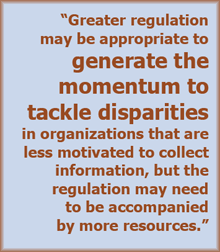Synopsis
A Commonwealth Fund–supported study of eight hospitals, health plans, and community health centers that collect data on patients’ race and ethnicity as part of efforts to address health care disparities found that the organizations vary in their approaches to defining and measuring disparities and in their ability to design effective disparity-reduction programs. The authors conclude that a lack of common standards governing the collection, analysis, and use of racial and ethnic data may hamper the ability of health care organizations nationally to design programs that effectively address inequities in patient care. The Issue
Racial and ethnic disparities in the quality of health care delivered in the United States are well documented. Reducing these disparities and improving quality requires health care organizations to take steps to define disparities, obtain accurate patient data for analysis, and use the information to design and implement interventions. This study interviewed staff at eight health care organizations—three hospitals, three health plans, and two community health centers—that collected race and ethnicity data for tracking and addressing disparities to learn about the methods used, the challenges faced, and the results achieved. Key Findings
- Hospitals were better able to collect and analyze racial and ethnic data than were health plans or community health centers, primarily because of the investments they had made in training and in information technology (IT) infrastructure. Interviewees in all three organizational types reported difficulties in data collection that were linked to a reluctance of staff to ask patients to report their race or ethnicity.
- There was substantial variability in the kinds of measures tracked, as well as inconsistency in the way organizations defined disparities.
- Several organizations used their findings on disparities to invest in new services or to improve existing ones, including mobile screening, enhanced interpreter services, and lower copayments for preventive care. One of the health plans conducted a focus group with physicians and surveyed patients to pinpoint the reasons for a disparity between black and white women in breast cancer screening. Once the plan determined that some women did not come in for screening because of inconvenient appointment times, it was able to persuade providers to make appropriate changes.
- The organizations participating in the study reported no direct competitive or financial advantages from concentrating on disparities. However, leaders did refer to a “good reputation among patients” as a future benefit.
- Only one organization, a hospital, had made the results of its data analysis public.
Addressing the Problem 
The first barrier the eight organizations faced was related to collecting data from patients. Community health centers, in particular, were challenged by a lack of technology and trained staff. In the future, these constraints could be eased as more resources are made available through the Affordable Care Act’s expansion of federally qualified health centers and from provisions in the American Recovery and Reinvestment Act to improve the quality and use of IT systems. In addition, the authors suggest policies to mandate the collection of patient data by health plans and standardize the gathering and analysis of these data. At the same time, they warn that policymakers will need to “find the right balance between regulation and the preservation of health care organizations’ autonomy to take the initiative on disparities.” About the Study
The authors selected eight organizations that collected patient self-reported data on race and ethnicity to measure and reduce disparities in the quality and outcomes of health care. At each site, they interviewed staff, including senior managers, clinicians, and data analysts. The Bottom Line
If health care organizations are to be held accountable for disparities in patient care, new policies and regulations may be required to ensure that they collect data on patients’ race and ethnicity and adhere to uniform standards for data collection and analysis, and that technical support is available to community health centers and other providers that need it.